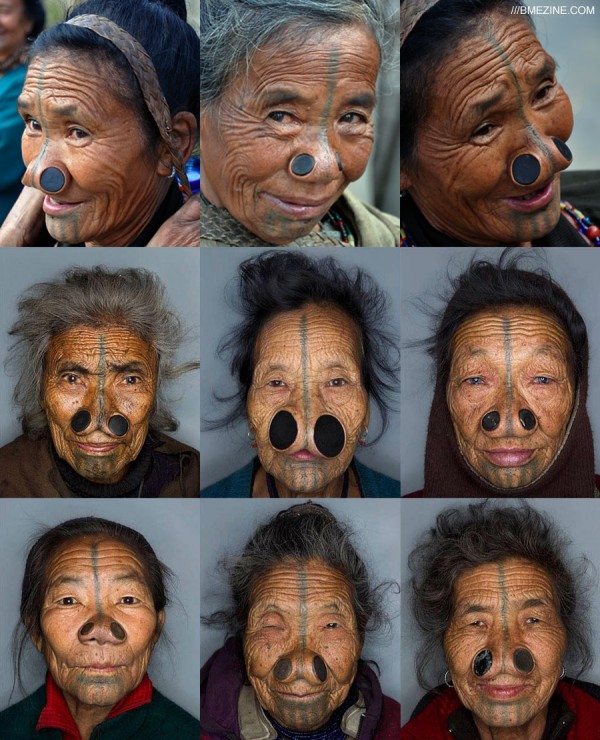As I’m sure you’ve seen before, the women of the Apatani (or Tani) Tribe who live an agricultural life in the Ziro valley of India wear massive nose jewelry of the sort championed more recently by bodmod celebrities like Pauly Unstoppable. They have only an oral history, with no written records, but legend holds that the nose jewelry has a dark history. The Apatani women were said to be the most beautiful of the region, and as a result their villages were constantly raided by neighboring tribes seeking to kidnap women to possess and rape. To defend themselves, the women began stretching the jewelry in their nostrils, tattooing a line down the centre of their face and then five lines on their chin. This was said to look so hideous to the raiders that they stopped stealing women, and the custom persisted until recently, but the youngest woman still wearing the style is currently forty-two years old.
With only an oral history, there is no way to know for sure whether this story is true, but I very strongly dispute this history. First of all, the tattooing is symmetrical in a way that accentuates beauty rather than disrupting it. A tattoo of this type draws attention to beauty. I do not believe it is the act of someone trying to damage beauty. The nostril stretchings as well, while highly unusual, are also symmetrical. Not only that, but they are a natural extension of body modification trends that were common in the area, and are consistent from person to person, thus becoming an aesthetic standard, rather than a disruption thereof. Are we really do believe that a hundred thousand people are going to go out overnight and mar their faces identically to spite raiding parties? It’s patently ridiculous. Especially when you consider — and our own culture is proof of this, with stretched ears going from disgusting to normal in a decade — that after half a generation of all women doing this that it would be considered a normal sign of an attractive woman.
The same ridiculous lie is often told of lip plates, but I think it is far, far, far more likely that this is a case of Victorian anthropologists being disgusted by it and not being able to wrap their head around this being beautiful to these people. So after ten years of these “experts” writing and repeating the story that it was a mark of ugliness, even the tribe started to believe it. After all, with only an oral history, it’s impossible to prove it one way or the other… and while that means we’ll never know for sure, every bit of my logic and experience tells me that this was done for beauty, not for ugliness.

 BME/News and Modblog highlight only a small fraction of what
BME/News and Modblog highlight only a small fraction of what
I think this is beautiful. These photos are amazing. Love them
For some reason, looking at their noses is really activating my trypophobia 0.0
amazing history!
Whilst the early Victorian anthropologists may well have been influenced by their attitudes towards the piercings, could not the same be said of yourself?
Could be both, a lot of the things considered conventionally attractive in our society were considered ugly/insignificant in the past.
I find it entirely plausible that these kinds of things were at some point used to ward off outsiders with different sensibilities but at the same time were revered as something beautiful and unique to their respective cultures.
As an anthropologist and fan of body mods, I’m really glad to read this commentary. I’ve heard various “explanations” for extreme modifications citing rape prevention and have always been skeptical.
It’d be a dream to get to do some real research on this one day!
There is plenty of evidence of it being rape-prevention, mainly direct from the sources themselves. Several transcribed interviews with the Tani share this story and there is one thing that these people do well is share stories It is incredibly unlikely that they would allow a deviation to be instilled into their culture without any form of rebuttal. It is also incredibly likely that if such a practice worked within one group then it would spread very successfully amongst other neighbouring groups.
Giles, it’s hard to say, because we have seen it happen numerous times. Culture and memory is a maleable thing, and I have seen no reason to trust the accuracy of the anthropologists of the time, many of whom were more about creating a Christ-centric mythology about savages….. Their poor job has left us at a point where much of the history is up for debate.
We finally found somebody with bigger nostril holes than Pauly Unstoppable! The lady in the center totally rocks!